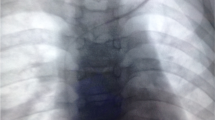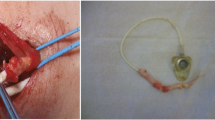Abstract
Purpose
Observational analysis of percutaneous repositioning of displaced port-catheters in patients with dysfunctional central-venous port-systems.
Methods
A total of 1061 patients with dysfunctional venous pectoral port-systems were referred for port-angiography. Dislocated port-catheters were identified in 37 (3.5 %) patients (11 males, mean age 58.1 ± 7.2 [range 48–69] years; 26 females, 57.0 ± 13.5 [range 24–75] years) 3.9 ± 6.6 months (range 1 day–26 months) after port-implantation. Percutaneous repositioning in all patients was performed by transfemoral catheter maneuvers, snaring, or wire-assisted long-loop snaring. Primary endpoint was successful repositioning. Safety endpoints included port-damage or procedure-related complications. Follow-up encompassed routine clinical and radiological controls, including chest X-ray or computed tomography for 12.9 ± 17.9 (range 1–81) months.
Results
Clinical signs of port-dysfunction due to dislocation of port-catheters included difficult aspiration in 23 (62.2 %), resistance or inability to inject in 17 (46.0 %), and pain during injection in 2 (5.4 %) patients. Primary technical success for repositioning displaced port-catheters was 97.3 % (36/37 patients). In 1 (2.7 %) patient, repositioning failed due to complete embedding of the port-catheter in an extensive chronic jugular vein thrombosis (Paget-von-Schroetter syndrome) that prevented endovascular access to the port-catheter. Redisplacement occurred after initial successful repositioning: immediately in two patients due to a too short port-catheter (two-tailed Fisher’s exact-test, p = 0.0101), and in two patients with appropriate catheter-length after 5, resp. 7 months. No procedure-associated complications, e.g., port-catheter disconnection or disruption, occurred.
Conclusions
Repositioning of dysfunctional displaced central-venous port-catheters with appropriate catheter-length is safe and effective. Even challenging conditions, e.g., wall-adherent port-catheter tip or a thrombosed catheter-bearing vein are feasible. Repositioning of too short port-catheters is ineffective.





Similar content being viewed by others
References
Lewis CA, Allen TE, Burke DR, Cardella JF, Citron SJ, Cole PE, et al. Quality improvement guidelines for central venous access. J Vasc Interv Radiol. 2003;14(9 Pt 2):S231–5.
Thomopoulos T, Meyer J, Staszewicz W, Bagetakos I, Scheffler M, Lomessy A, et al. Routine chest X-ray is not mandatory after fluoroscopy-guided totally implantable venous access device insertion. Ann Vasc Surg. 2014;28(2):345–50.
Kulkarni S, Wu O, Kasthuri R, Moss JG. Centrally inserted external catheters and totally implantable ports for the delivery of chemotherapy: a systematic review and meta-analysis of device-related complications. Cardiovasc Intervent Radiol. 2014;37(4):990–1008. doi:10.1007/s00270-013-0771-3.
Vazquez RM, Brodski EG. Primary and secondary malposition of silicone central venous catheters. Acta Anaesthesiol Scand Suppl. 1985;81:22–6.
Pikwer A, Bååth L, Davidson B, Perstoft I, Akeson J. The incidence and risk of central venous catheter malpositioning: a prospective cohort study in 1619 patients. Anaesth Intensive Care. 2008;36(1):30–7.
Kowalski CM, Kaufman JA, Rivitz SM, Geller SC, Waltman AC. Migration of central venous catheters: implications for initial catheter tip positioning. J Vasc Interv Radiol. 1997;8(3):443–7.
Rutherford JS, Merry AF, Occleshaw CJ. Depth of central venous catheterization: an audit of practice in a cardiac surgical unit. Anaesth Intensive Care. 1994;22(3):267–71.
Nazarian GK, Bjarnason H, Dietz CA Jr, Bernadas CA, Hunter DW. Changes in tunneled catheter tip position when a patient is upright. J Vasc Interv Radiol. 1997;8(3):437–41.
Forauer AR, Alonzo M. Change in peripherally inserted central catheter tip position with abduction and adduction of the upper extremity. J Vasc Interv Radiol. 2000;11(10):1315–8.
Vesely TM. Central venous catheter tip position: a continuing controversy. J Vasc Interv Radiol. 2003;14(5):527–34.
Schutz JCL, Patel AA, Clark TWI, Solomon JA, Freiman DB, Tuite CM, et al. Relationship between chest port catheter tip position and port malfunction after interventional radiologic placement. J Vasc Interv Radiol. 2004;15(6):581–7.
Caers J, Fontaine C, Vinh-Hung V, De Mey J, Ponnet G, Oost C, et al. Catheter tip position as a risk factor for thrombosis associated with the use of subcutaneous infusion ports. Support Care Cancer. 2005;13(5):325–31.
Massmann A, Jagoda P, Kranzhoefer N, Buecker A. Local low-dose thrombolysis for safe and effective treatment of venous port-catheter thrombosis. Ann Surg Oncol. 2015;22(5):1593–7. doi:10.1245/s10434-014-4129-0.
Hawkins IF Jr., Paige RM. Redirection of malpositioned central venous catheters. AJR Am J Roentgenol. 1983;140(2):393–4.
Lois JF, Gomes AS, Pusey E. Nonsurgical repositioning of central venous catheters. Radiology. 1987;165(2):329–33.
Hartnell GG, Gates J, Suojanen JN, Clouse ME. Transfemoral repositioning of malpositioned central venous catheters. Cardiovasc Intervent Radiol. 1996;19(5):329–31.
Gebauer B, Teichgräber UK, Podrabsky P, Werk M, Hänninen EL, Felix R. Radiological interventions for correction of central venous port catheter migrations. Cardiovasc Intervent Radiol. 2007;30(4):668–74.
Conflict of interest
All authors have nothing to disclose.
Author information
Authors and Affiliations
Corresponding author
Electronic supplementary material
Below is the link to the electronic supplementary material.
Supplementary material 1 Video 1: The displaced port-catheter is hooked by a 100 cm 5F-pigtail-catheter and then gently pulled down for repositioning of the port-catheter into the superior vena cava. (MOV 3558 kb)
10434_2015_4549_MOESM3_ESM.mov
Supplementary material 3 Video 3: Twisting of the pigtail-catheter around the port-catheter similar to Asclepius’ rod assures stabilization and better fixation for successful repositioning. (MOV 4863 kb)
10434_2015_4549_MOESM4_ESM.mov
Supplementary material 4 Video 4: Snaring (covidien-ev3, goose-neck) guarantees a secure fixation of the port-catheter tip. (MOV 1329 kb)
10434_2015_4549_MOESM5_ESM.mov
Supplementary material 5 Video 5: After secure fixation of the port-catheter tip, the snare is gently pulled down for correction of the displaced port-catheter into the superior vena cava. Care has to be taken not to harm the port catheter by the snare. (MOV 366 kb)
10434_2015_4549_MOESM6_ESM.mov
Supplementary material 6 Video 6: After grasping the tip of the displaced port-catheter, the snare is gently pulled down for repositioning. (MOV 1642 kb)
10434_2015_4549_MOESM7_ESM.mov
Supplementary material 7 Video 7: An advanced wire-assisted long-loop repositioning technique is used for an inaccessible port-catheter tip e.g. due to wall-adherence or thrombosis of the catheter-bearing vein. A pigtail-catheter is placed over the port-catheter. A standard 0.89 mm (0.035”) tip-deflecting guidewire is advanced into the superior vena cava. The guidewire is snared and repositioning of the port-catheter is achieved by pulling down the proximal end of the guidewire together with the distal end of the guidewire that is fixated by the snare. (MOV 1684 kb)
Supplementary material 8 Video 8: Upper extremity ab- and adduction combined with Valsalva-manoeuver and forceful coughing is used to verify a stable position of the corrected port-catheter. (MOV 1616 kb)
Rights and permissions
About this article
Cite this article
Massmann, A., Jagoda, P., Kranzhoefer, N. et al. Percutaneous Re-positioning of Dislocated Port-Catheters in Patients with Dysfunctional Central-Vein Port-Systems. Ann Surg Oncol 22, 4124–4129 (2015). https://doi.org/10.1245/s10434-015-4549-5
Received:
Published:
Issue Date:
DOI: https://doi.org/10.1245/s10434-015-4549-5




